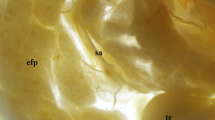Summary
The testis and epididymis of man was investigated by means of Falcks and Hillarps method for the fluorescence-microscopical detection of catechol- and tryptamines. It is shown that in the testis and epididymis there are nerve fibres containing catecholamines. These are located in small varicosities along the nerve fibres and particularly near their terminals. The nerve fibres form plexus around small blood-vessels. Some nerve fibres run through the interstitial tissue to approach Leydig-cells and others to approach the lamina propria of the tubuli contori of the testis.
Zusammenfassung
Mit Hilfe der von Falck und Hillarp entwickelten Methode zur fluoreszenzmikroskopischen Lokalisation von Catechol- und Tryptaminen konnten im Hoden und Nebenhoden des Menschen grünfluoreszierende Nervenfasern nachgewiesen werden. Sie bilden Geflechte um kleine Blutgefäße; einzelne Fasern ziehen durch das Interstitium und nehmen Kontakt mit Leydig-Zellen und der Lamina propria der Tubuli contorti des Hodens auf. An den Berührungsstellen kommen intensiv fluoreszierende Varicositäten vor.
Similar content being viewed by others
Literatur
Baumgarten, H. G.: Vorkommen und Verteilung adrenerger Nervenfasern im Darm der Schleie (Tinca vulgaris Cuv.). Z. Zellforsch. 76, 248–259 (1967).
Berger, L.: Sympathicotrope Zellen im Eierstock und ihre neurokrine Funktion. Zugleich ein Beitrag zur Frage der Hodenzwischenzellen. Virchows Arch. path. Anat. 267, 433–445 (1928).
Carlsson, A., B. Falck, and N. A. Hillarp: Cellular localization of brain monoamines. Acta physiol. scand. 56, Suppl. 196, 1–28 (1962).
Clermont, Y.: Contractile elements in the limiting membrane of the seminiferous tubules of the rat. Exp. Cell Res. 15, 438–440 (1958).
Corrodi, H. G., N. A. Hillarp, and G. Jonsson: Fluorescence methods for the histochemical demonstration of monoamines. 3. Sodium borohydride reduction of the fluorescent compounds as a specificity test. J. Histochem. Cytochem. 12, 582–586 (1964).
Falck, B., and Ch. Owman: A detailed methodological description of the fluorescence method for the cellular demonstration of biogenic amines. Acta Univ. lund., Sect. II, No 7, 1–23 (1965).
Gray, D. J.: The intrinsic nerves of the testis. Anat. Rec. 98, 325–335 (1947).
Letzerich, L.: Über die Endigungsweise der Nerven in den Hoden der Säugethiere und des Menschen. Virchows Arch. path. Anat. 42, 570–575 (1868).
Montagna, W., and J. B. Hamilton: Histological studies of human testes. I. The distribution of lipids. Anat. Rec. 109, 635–659 (1951).
Murakami, M.: Elektronenmikroskopische Untersuchungen am interstitiellen Gewebe des Rattenhodens, unter besonderer Berücksichtigung der Leydigschen Zwischenzellen. Z. Zellforsch. 72, 139–156 (1966).
Norberg, K. A., P. L. Risley, and U. Ungerstedt: Adrenergic innervation of the male reproductive ducts in some mammals. I. The distribution of adrenergic nerves. Z. Zellforsch. 76, 278–286 (1967).
Okkels, H., and K. Sand: Morphologic relationship between testicular nerves and Leydig-cells in man. J. Endocr. 2, 38–46 (1940).
Peters, H.: Über die feinere Innervation des Hodens insbesondere des interstitiellen Gewebes und der Hodenkanälchen beim Menschen. Acta neuroveg. (Wien) 15, 235–242 (1957).
Romeis, B.: Mikroskopische Technik. München: R. Oldenbourg 1948.
Roosen-Runge, E. C.: Motions of the seminiferous tubules of rat and dog. Anat. Rec. 109, 153 (1951).
Ross, N. H., and J. R. Long: Contractile cells in human seminiferous tubules. Science 153, 1271–1273 (1966).
Sclavunos, G.: Über die feineren Nerven und ihre Endigungen in den männlichen Genitalien. Anat. Anz. 9, 42–51 (1894).
Stieve, H.: Der Einfluß des Nervensystems auf Bau und Tätigkeit der Geschlechtsorgane des Menschen. Stuttgart: Georg Thieme 1952.
Stöhr jr., Ph.: Innervation des Genitalsystems. In: Handbuch der mikroskopischen Anatomie des Menschen, Bd. IV/V (hrsg. von W. Bargmann). Berlin-Göttingen-Heidelberg: Springer 1957.
Timofeew, D.: Zur Kenntnis der Nervenendigungen in den männlichen Geschlechtsorganen der Säuger. Anat, Anz. 9, 342–348 (1894).
Watzka, M.: Die Leydigschen Zwischenzellen im Funiculus spermaticus des Menschen. Z. Zellforsch. 43, 206–213 (1955).
Author information
Authors and Affiliations
Additional information
Mit dankenswerter Unterstützung durch eine Sachbeihilfe der Joachim-Jungius-Gesellschaft zur Förderung der Wissenschaften, Hamburg, an Prof. Fleischhauer.
Rights and permissions
About this article
Cite this article
Baumgarten, H.G., Holstein, A.F. Catecholaminhaltige Nervenfasern im Hoden des Menschen. Zeitschrift für Zellforschung 79, 389–395 (1967). https://doi.org/10.1007/BF00335483
Received:
Issue Date:
DOI: https://doi.org/10.1007/BF00335483



